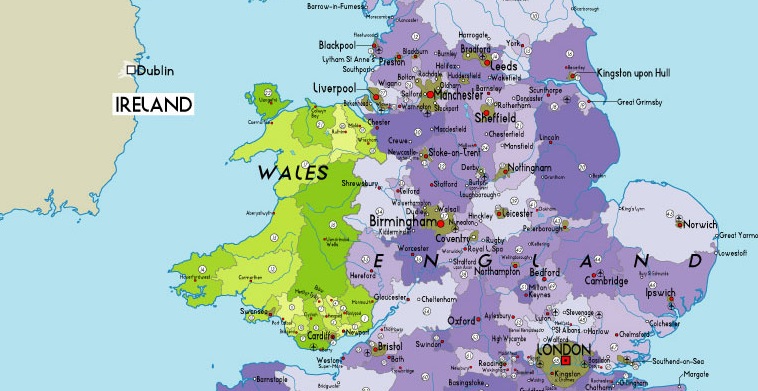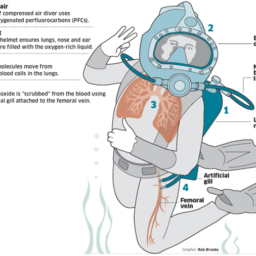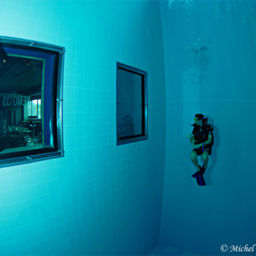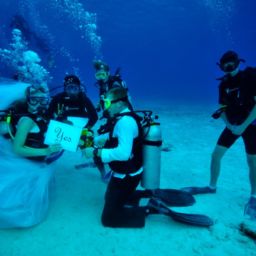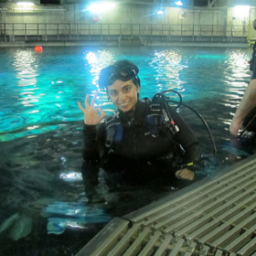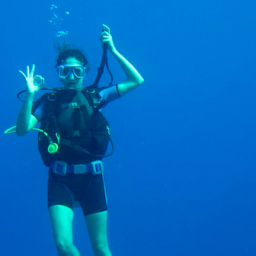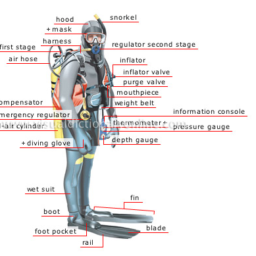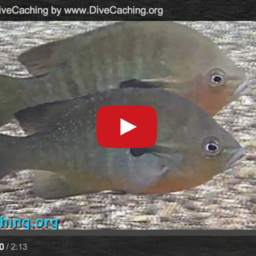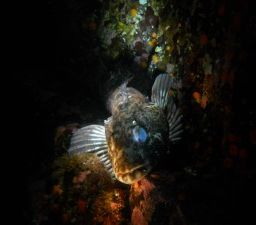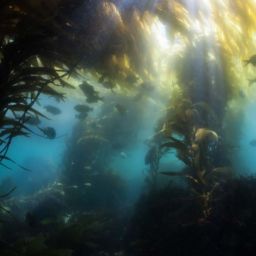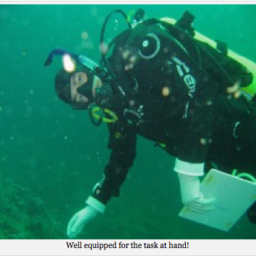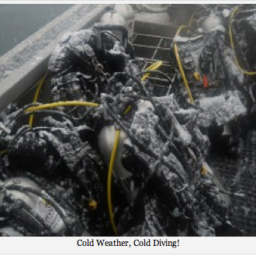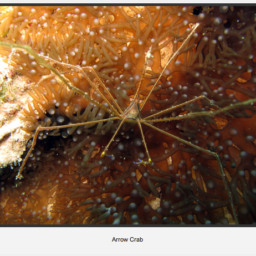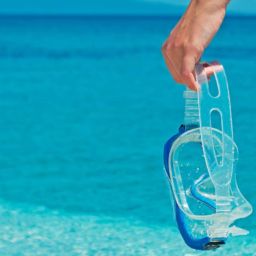Farne Islands, Northumberland
| Water temperature: | 5°C (41°F) in winter to 18°C (64°F) in summer (southern England), 4°C (39°F) in winter to 13°C (55°F) in summer (Scotland) |
| Suit: | Drysuit for most of the year, but a semidry is sufficient from June to October, or all year round if you are hardy enough! |
| Visibility: | 1 – 25 metres (3 – 80 feet) |
| Type of diving: | Wrecks, caves, reefs, walls, piers, caverns, kelp forests |
| Marine life: | Basking sharks, seals, cuttlefish, octopus, conger eels, lobsters, crabs, seahorses, bib, pollack, bass, wrasse, blennies, gobies… and so on |
| When to go: | Some divers in the UK dive throughout the year, by making use of inland sites. Diving in the sea is generally possible from April through to October. Undeniably conditions are more pleasant in the summer months when temperatures are warmer and the sea is calm. |
If you haven’t got any issues with cold water diving, the following destinations will leave you breathless. Is found in Scotland, in the Sound of Mull. The Sound of Mull is found between the Isle of Mull and the Morven Cape . It’s an intensely popular destination for U.K. Divers as it offers an unique range of diving in particularly reasonable conditions. The area is cursed with stormy weather, which has resulted in numerous shipwrecks over time.
Most dives in the area are launched from Tobermory, Lochaline, or Oban. The Hispania is, by far, one of the hottest wrecks in the area, because of the fact it’s still comparatively untouched and deluged in marine life.
It is shallow enough to get a good long dive, and visibility is normally excellent. Another unusual dive spot is found on the south coast of Britain, in the waters of Sussex. Though the wreck is significantly split up, there are still significant parts of the ship left untouched.
Be looking for a sequence of portholes to help navigate the site. If you can come up with a way to find the bridge area, you may unquestionably be contented to find the anchor still hanging from its chain. The dimensions of the wreck is overpowering to a certain degree, and it would probably take 1 or 2 separate dives to explore the whole ship. Shoals of bib, spider crabs, and great lobsters will definitely keep you entertained. Another highly popular dive is found near Plymouth, where the wreck of the liner Maine found its last resting place. It was highly obvious for several years, as the masts of the ship broke the outside of the water. The wreck has after that been cleared of its mast, with many of the waste swept to its port side. It rests in water that’s roughly thirty meters deep. The ship was torpedoed in March of 1917 and, after a noble rescue effort, came to rest in waters inside close range from Salcombe. While this would be a superb exploration for any diver, it’s not advised for novice divers because of the powerful current.
There’s a good representation of undersea life, and this destination is sure please anyone that visits.
Here are 10 top dive sites in Britain as stated by Time.com
The Manacles, off the Lizard Peninsula, Cornwall
Located a short distance from The Lizard coast, the granite reef of the Manacles offers some of the most fun you can have with flippers in Britain. This popular dive site is home to a variety of marine life including several starfish species such as the common, cushion and spiny starfish and wrasse, which reach up to 50cm in length. In summer, you may even spot a pod of dolphins cruise by.
Scapa Flow, Orkney Islands
Scotland has many great dive sites including the marine nature reserve of St Abbs and Eyemouth, but top of the list for many is the scuttled German World War One Fleet which lies in the rather ominous sounding Scapa Flow in the Orkney Islands. Divers are drawn here to explore 180-metre-long, 36,000-tonne battleships that still have everything from guns to teak decking.
Challaborough Beach, South Devon
Russell Troake, PADI Scuba Instructor, describes the wreck of the “Persier” as being his favourite British dive site. This Belgian steamer was torpedoed and sank in 1945 and can now be reached on a 10 minute RIB boat ride from Challaborough Beach, South Devon. He says: “The wreck lies in about 30m of water – as well as an abundance of fish, there are beds of soft pink coral fans to be discovered. Highlights include swimming over the mast, rigging and winches and searching for crabs, lobsters and conger eels.”
Scomer Island, Pembrokeshire
Pembrokeshire has some of the most spectaclar coastal scenery in Britain and below the waves there’s plenty to see too. The array of sea life in these waters includes dolphins, porpoises and seals as well as brightly coloured wrasse and impressive coral species. Skomer Island, being a marine nature reserve, is a popular destination. There are dive sites which cater for both learner divers and the more experienced. In addition to shallow reef dives and drift dives, there’s also the wreck of The Lucy for more experienced divers to explore. This 52-metre vessel ran aground in 1967 and now sits in 40 metres of water.
Lundy Island, Bristol Channel, Devon
This car-free island is an unspoilt habitat enjoyed by a large variety of wildlife including migratory seabirds and the Lundy ponies. Like Scomer Island, this is a marine nature reserve and large parts of the surrounding water are protected as a “no take” zone for fish and other marine life. All good news for divers who come to experience this unique environment. Lundy is also a good location for diving with seals.
Farne Islands, Northumberland
The Farne Islands are well known for their seabirds – especially the puffin population. Under the waves, there’s another attraction for wildlife watchers. Alison Dando of BSAC describes the appeal: “The waters here are heaving with underwater life, but the star act has to be the grey seals. It’s such an amazing experience to swim with these magnificent creatures who will interact and play with you, coming up close to nip your fins and weave in and out of your air bubbles. I would recommend it to everyone.”
Isles of Scilly
The Isles of Scilly are as close as Britain gets to having picture postcard tropical islands. If you’re still searching for an excuse to visit, pack your wetsuit and make the most of these unspoilt waters which are well known for their good levels of visibility. There are well over 100 dive sites, and highlights include a lifetime’s supply of wrecks to explore and a possible encounter with the playful local seals.
Bowleaze Cove, Weymouth, Dorset
At the eastern end of Weymouth Bay, Bowleaze Cove is a fairly standard stretch of sand. However, it’s definitely worth a visit with your snorkel and fins. You can stroll right into an underwater adventure, just a few metres out from the shore. There’s a large natural underwater garden with a mini-forest of fern-like plants extending dramatically from the sandy floor below and swaying lazily along the waves. Also, keep your eyes peeled for wrasse, sea bass and pipefish darting between the rocks.
Drawna Rock, Porthkerris, Cornwall
Freediving instructor, Sam Kirby (no relation) recommends her favourite snorkelling spot: “My first ever real look beneath the surface was at Drawna Rock and it remains a favourite. Stay inside the rocks and swim around in the wrasse pool, spot mini-versions of monkfish, pollock in the “nursery” and keep your eyes peeled for cuttle-fish or octopus. Venture outside and you might just spot a sea bass, giant jellyfish, a seal or even a sunfish. Easily accessible by car, you can just park on the beach at Porthkerris and walk in.”
Boscombe, Bournemouth
A snorkelling destination currently under construction is the artificial surf reef being built at Boscombe this summer. Although designed to keep the surfers happy, the reef is also tipped to become a haven for sea life and corals. At a maximum depth of six metres, the reef will be relatively accessible too.
Need to know
Both the British Sub-Aqua Club (BSAC) and the Professional Association of Diving Instructors (PADI) offer a wide range of diving courses for both children and adults, and to snorkel you’ll just need a mask and fins. However, always seek expert tuition and follow safety advice. To find a local accredited diving centre visit: www.bsac.org or www.padi.com and to learn more about freediving contact Saltfree Divers at: www.saltfreedivers.com


